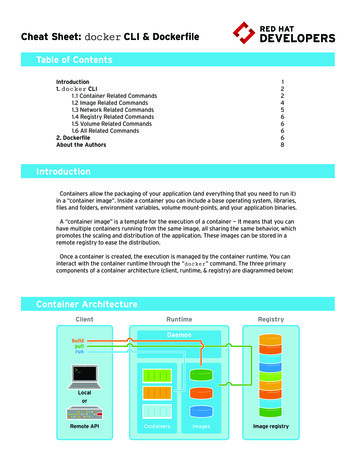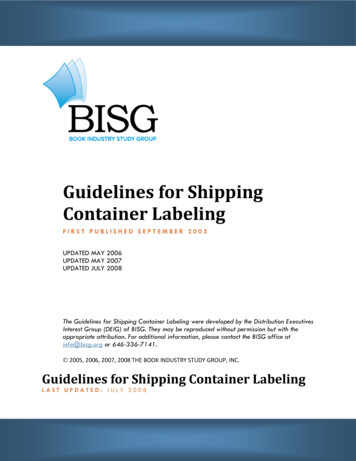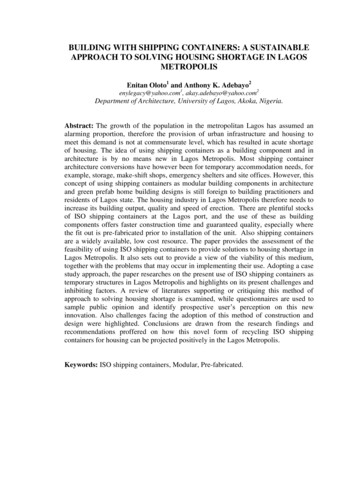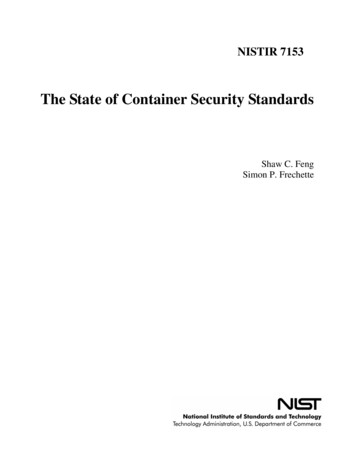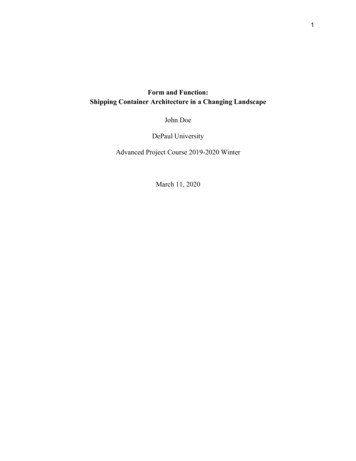
Transcription
1Form and Function:Shipping Container Architecture in a Changing LandscapeJohn DoeDePaul UniversityAdvanced Project Course 2019-2020 WinterMarch 11, 2020
2Table of ContentsAbstract . . . . . . . . . . . . . . . . . . . . . . . . . . . . . . . . . . . . . . . . . . . . . . . . . . . . . . . . . . . . . . . . . . . . .3Housing Issues. . . . . . . . . . . . . . . . . . . . . . . . . . . . . . . . . . . . . . . . . . . . . . . . . . . . . . . . . . . . . . . .4Shipping Container Facts. . . . . . . . . . . . . . . . . . . . . . . . . . . . . . . . . . . . . . . . . . . . . . . . . . . . . . . .6Design Achievements. . . . . . . . . . . . . . . . . . . . . . . . . . . . . . . . . . . . . . . . . . . . . . . . . . . . . . . . . . 7Design Challenges. . . . . . . . . . . . . . . . . . . . . . . . . . . . . . . . . . . . . . . . . . . . . . . . . . . . . . . . . . . . .10Case Studies. . . . . . . . . . . . . . . . . . . . . . . . . . . . . . . . . . . . . . . . . . . . . . . . . . . . . . . . . . . . . . . . . .12Case Study #1 - Meboneng Precinct . . . . . . . . . . . . . . . . . . . . . . . . . . . . . . . . . . . . . . . . .12Case Study #2 - Keetwonen Student Housing Project. . . . . . . . . . . . . . . . . . . . . . . . . . . .13Industry Perspectives. . . . . . . . . . . . . . . . . . . . . . . . . . . . . . . . . . . . . . . . . . . . . . . . . . . . . . . . . . .16Social Impacts. . . . . . . . . . . . . . . . . . . . . . . . . . . . . . . . . . . . . . . . . . . . . . . . . . . . . . . . . . . . . . . . 20Discussion. . . . . . . . . . . . . . . . . . . . . . . . . . . . . . . . . . . . . . . . . . . . . . . . . . . . . . . . . . . . . . . . . . . 23Conclusion. . . . . . . . . . . . . . . . . . . . . . . . . . . . . . . . . . . . . . . . . . . . . . . . . . . . . . . . . . . . . . . . . . .26References. . . . . . . . . . . . . . . . . . . . . . . . . . . . . . . . . . . . . . . . . . . . . . . . . . . . . . . . . . . . . . . . . . . 28Table 1. . . . . . . . . . . . . . . . . . . . . . . . . . . . . . . . . . . . . . . . . . . . . . . . . . . . . . . . . . . . . . . . . . . . . .31Glossary. . . . . . . . . . . . . . . . . . . . . . . . . . . . . . . . . . . . . . . . . . . . . . . . . . . . . . . . . . . . . . . . . . . . 31Glossary References. . . . . . . . . . . . . . . . . . . . . . . . . . . . . . . . . . . . . . . . . . . . . . . . . . . . . . . . . . . .33
3AbstractWith growing populations and changing economics, Southern California is currently facing ahousing crisis. Environmental concerns, limited resources, and local legislation add to thecomplexities of this issue. Architects and designers are using shipping containers, in variouscommercial, public, and residential applications, to resolve some of these challenges in variousparts of the world. Many professionals within the industry are touting container construction as acost-effective, safe, and efficient alternative to architecture constructed using traditional buildingmaterials.The purpose of this stand-alone research paper is to examine data related to shipping containerarchitecture to further understand its practicality, advantages, and limitations when used in aresidential application. Critical data will be obtained through library and online research,interviews with working professionals, case study reviews, and the use of industry relatedpublications.The goal is to help design professionals and civic officials understand the basic facts of shippingcontainer architecture while providing additional detailed analysis to determine if this designconcept can be considered a viable option to help resolve components of the housing crisisexperienced in Southern California.Keywords: shipping container architecture, architect, residential
4Form and Function:Shipping Container Architecture in a Changing LandscapeAlthough California has historically been an expensive place to live, Southern Californiahas been facing a housing crisis that has gained national attention over the past twelve years.Population growth, a changing economic environment, climate and natural resource concerns, aswell as archaic legislation have all added to the complex housing-related issues that Californiansface every day (Buhayar & Cannon, 2019). Though multiple cities and counties within the statehave sponsored research in how to help address these issues, California still faces thesechallenges. Professionals within the design industry have constructed innovative methods usingshipping containers to help address some of these issues. Many professionals within the industrybelieve this design concept offers cost-effective, safe, and efficient solutions to these widespreadissues. Through various design applications throughout the world, designers are helping changethe perception of shipping container architecture. Even with its challenges, shipping containerarchitecture can potentially have a positive impact on neighborhoods, the environment, and thequality of life of its residents. This study helps examine the innovative concepts of shippingcontainer architecture to scrutinize its viability in addressing housing-related issues.Housing IssuesAccording to Buhayar and Cannon (2019), the median price for a house in Californianow averages just over 600,000, which is more than twice the national level. Out of thecountry’s seven most expensive housing markets, five belong to California, with three of thembeing located in the southern part of the state. These markets are responsible for more than 50%of San Diego households being cost burdened (more than 30% are considered severely cost
5burdened) where they are designating nearly half of their monthly income to housing (JCHS,Harvard University, 2020).Local legislation also has influence over housing related issues. In an effort to preserveland and protect the environment, the “Not in my backyard” or NIMBY clause was enacted. Thisprotects communities by limiting the amount of new development. This limits the amount ofinventory to meet the demands of urban growth thus affecting affordability. As residents movefurther out of the city in hopes of cheaper alternatives, they are faced with new challenges in theform of wildfires. Due to climate change, wildfires have become more frequent resulting inpersonal devastation and billions of dollars in associated expenses. This increased risk limitsdevelopment in new areas thus keeping the current inventory in high demand and prices high.A price to income ratio (PIR) is typically the standard formula for gauging affordabilityof housing within a specified region that represents the ratio of a median house price to a personor family’s annual income. In short, it is the amount of a household’s income that is devoted tohousing expense (Sani, 2015). Historically, the standard rule for PIR, used by the real estateindustry, was that the cost of a house should equal approximately 2.6 years worth of householdincome (Florida, 2018). As of 2017, San Diego’s PIR was over 8%, well above the historicalnational average (JCHS, Harvard University, 2018). Skewed PIRs, minimal “low-rent” optionsand inventory, as well as increased land value pricing have all contributed to why largecompanies like Facebook have subsidized housing for teachers who could not afford their rent,or the fact that policemen in various California cities resorted to sleeping in their cars. Thesesituations are some of the reasons why California makes up nearly 25% of the country’shomeless (Buhayar & Cannon, 2019).
6Shipping Container FactsAlthough shipping containers were originally intended to standardize the transport ofgoods from one place to another, engineers and architects started to see their potential for otherunintended uses. Soon after, shipping containers were being integrated into architectural plansfor residential, commercial, and military applications. This new approach to architecture hasbeen adopted by many architects and designers who feel that this alternative to traditional designcan not only address some of the current housing-related issues challenging the west coast of theUnited States but can do it with an aesthetic that is attractive and manageable to the builder,governing officials, the community and ultimately the client.The standardized shipping container is a fairly recent invention. Malcolm McLean, theowner of one of the largest trucking companies in the United States in the 1950s, was frustratedby the lack of standardization within the shipping industry. McLean patented the first shippingcontainer in 1956 which allowed him to experiment with his concept. After multiple attempts, hefinalized a design that is now known as the International Organization for Standardization (ISO)shipping container. Due to its uniform design, durability, strength, and storage capacity, it is thestandardized container used in various methods of transport throughout the world (ISBUA,2016).ISO shipping containers have standardized specifications that typically come either in 20ft (6.096 m) or 40 ft (12.192 m) lengths and are 8 ft 6 in (2.591 m) high. Both sizes come in astandardized width of 8 ft (2.438 m) which is why they are easily stackable. Their cubic footageis either approximately 1,700 ft3 (33 m3) or 2,400 ft3 (67 m3) respectively. Standard containerdimensions are presented in Table 1 (Moore, Yildirim, & Baur, 2015, p. 2). Their constructionconsists of steel, aluminum, reinforced polymer, and wood. They have corrugated steel walls,
7joists, and tops (optional) that are welded to steel rails and end-frames. Hinged doors with rubberseals and marine-grade wood flooring are used to ensure water resistance. Once completed, atypical container weighs approximately 8,400 pounds. According to Western Container Sales’website located at https://westerncontainersales.com/shipping- container-prices/los-angeles/, ashipping container wholesaler located in Los Angeles, California, typical costs for a new, onetrip, ISO dry goods shipping container averages between 2,600 and 5,000 depending on thesize. Used containers have an average price range between 1,200 to 2,900.Design AchievementsThese specifications are only a few of the reasons that make shipping containers soappealing to advocates of this style of architecture. One of the major contributing factors to itsappeal is the cost effectiveness of the product. Typically lower in cost when compared to new,used shipping containers can significantly reduce the overall costs of a residential housingproject. Even with ancillary costs associated with design plans, delivery, permits, sitepreparation, infill, and customization, shipping container dwellings typically run almost half theprice per square foot of conventionally built structures. A typical schema for a basic single storycontainer based apartment can cost as low as 15,000. While this does not include transportation,site preparation, or furnishing, a significant savings is still gained in comparison to traditionalconstruction (Berbesz & Szefer, 2018, pp. 2-3).The ISO standardization that makes containers so functional in the transportation industryis what makes shipping container architecture so cost effective in the housing market.Standardization allows architects and designers the benefit of prefabrication. This advantagereduces the time needed to over customize architectural and mechanical plans, resulting in areduction of design time, on-site construction, and additional costs. Additionally, certain building
8materials can be prefabricated and drop shipped directly to the building site for immediateinstallation. According to SG Blocks, a leader within the container environment industry, thistype of technology helps to shorten construction time by up to 40% and reduce costs up to 70%(Berbesz & Szefer, 2018, pp. 3-4). Economically, there is an undeniable advantage of usingshipping container architecture to reduce building costs and construction time.Globally, we consume raw materials, for the purpose of building materials, that has anacute impact on the environment. Millions of acres of forest are harvested, materials needed forbuilding are produced in factories and transported in vessels that generate pollution. The U.S.Green Building Council states that building construction accounts for “39% of U.S. primaryenergy use; 70% of U.S resource consumption; use 12.2% of all potable water, or 15 trilliongallons per year; and consume 40% of raw materials globally (3 billion tons annually)”(USGBC, Senate Statement, 2007). Depending on the site, container construction typicallyrequires less cement. There are some sites that do not require the use of cement at all. Thissupports a more environmentally friendly approach to building since the cement industry isnotorious for being one of the biggest producers of carbon emissions.According to Drewry Maritime Research, harbors around the world stored over 30million containers since 2012 (Moore, Yildirim, & Baur, 2015, p. 3). Financially, transportingcontainers without cargo, back to its original port is not cost-effective, so repurposing andupcycling containers is not only fiscally effective, but offers the opportunity to build withmaterials that would have gone unused and become global waste.Due to increased risk of wildfires, climate change as a whole, has reduced the zones inwhich developers are allowed to build. This issue is compounded by strict legislative conditionsthat reduce the availability of land, making building opportunities scarce, thus driving up prices.
9Depending on the application, the modularity of container construction makes it possible toaccommodate a higher volume of dwellings while reducing its land footprint.The process to convert a container into a living space does require the use of resources.Sand blasting as well as the abatement of certain waterproofing chemicals and insecticides, areneeded prior to installation. Additionally, openings for windows and doors must be constructed.Newer containers are being constructed using bamboo flooring which is a more sustainableproduct than hardwood. On average, a shipping container uses approximately 500 kWh of energyduring its recycling process to become habitable. The disposal of an empty container typicallyrequires almost 8,000 kWh of energy (Berbesz & Szefer, 2018, pp. 2-3). When comparing thedifference in carbon emissions between building a two-story single family house usingtraditional architecture techniques (approximately equal to 88 tons) to building a two-storyshipping container architecture using two 40’ containers (approximately equal to 20 tons), it iseasy to see which style leaves a smaller footprint (Falcon Structures, n.d.).Climate change is being felt in all parts of the globe and Southern California is nodifferent. Strong winds and long periods of drought means that most of California is at high riskand subject to wildfires. This part of the country is also prone to earthquakes. Shippingcontainers have proven to be affordable housing solutions in this type of climate. When used intheir original capacity, shipping containers are designed, and charged, with bearing heavy loadsand transporting valuable cargo in extreme weather conditions (Radwan, 2015, pp. 1562-1564).Their steel framing makes them resistant to fires, and when properly anchored and installed, theyare seismically sound and can withstand hurricane strong winds (Dugal et al., 2016). In responseto shipping container architecture’s popularity and acceptance, regulatory agencies, engineers,
10designers, and other leaders within the industry are starting to work together to create guidelinesand permits that will ensure its continued and enhanced safety.Design ChallengesIn spite of its numerous advantages, shipping container architecture has its share ofchallenges and opponents. While most architects and industry professionals agree that containerarchitecture can be the right solution in the correct situation, some feel that the challenges simplyoutweigh the advantages under most conditions. “Carbon footprint” awareness and the growingacceptance of sustainable construction are responses to the unpredictability and volatility ofclimate change within the environment. Part of the sustainable appeal in shipping containerarchitecture is the fact that used containers can be repurposed, thus reducing the amount ofunused materials throughout the globe.Since shipping containers are not intended for human habitation, chemicals such aschromate, phosphorous, arsenic and chromium, normally used as insecticides, must be removedprior to construction. Lead-based paints are often used when building containers and thereforemust be removed during the sand blasting process. Containers are designed to have a lifespan ofapproximately 10 years. Used containers typically have dents and scratches which occurredduring usage and transport. In order to maintain their lifespan, the dents and scratches must berefurbished to mitigate rust and further degradation. Refurbished containers that are paintedregularly can extend the container lifespan by more than 20 years (Dugal et al., 2016).Once a container has gone through a complete abatement process, it is ready forinstallation. This brings on a new set of challenges. Because of their steel construction, theyquickly absorb heat and cold, thus making it difficult to regulate interior temperatures. While thisissue can be mitigated, insulation (this can also be a detriment to the environment depending on
11the type used) requires space which reduces the interior dimensions. Containers come in astandardized width of eight feet. Once insulation is installed, the interior dimension is reduced toseven, making for a narrow living space. International Residential Code R304.1 states thathabitable rooms (typically living and sleeping) need to have a minimum of 70 square feet(6.5m2) which includes a minimum length and width of seven feet (International ResidentialCode, 2018). Utilities also pose challenges to container architecture. Traditional constructionallows builders to conceal electrical, plumbing, and other mechanical utilities behind walls,ceilings, and floors. While most electrical wiring is small enough to fit behind finished wallswithin the container, polyvinyl chloride (PVC) piping and heating, ventilation, and airconditioning (HVAC) ducts are not as forgiving. Sites, like those in Southern California, wherehot weather is a concern, traditional central air conditioning cannot usually be installed due to thelack of space for HVAC ductwork (Discover Containers, n.d.).Shipping container architecture has a series of complex requirements that is oftenconfusing to building officials. It is very common that rules differ depending on whether theentire installation takes place on-site or if some of the parts come prefabricated and areconstructed off-site. Interpretation of building codes and legislation is also a challenge whendealing with officials. Those who are unfamiliar with this style of building are often confusedand determine compliance based on their own interpretation. Ambiguous building codes, zoninglaws, and state legislation can often lead to struggles and occasional design modifications(Discover Containers, n.d.).Shipping container architecture has been recognized and deployed through the jointefforts of architects, builders, interior designers, and urban planners throughout the world. Themodular nature of containers have proven to be a successful solution to various multi-unit
12dwellings that could potentially be used as a foundation in helping address certain housingrelated issues in southern California.Case studies of these applications can provide qualitative exploration to betterunderstand, and compare, the theories and logic behind the solutions. Two case studies havebeen included to review how this particular architectural design concept has been used indifferent parts of the globe to address acute housing challenges. Examination of these conceptsmay not be conclusive but will provide details that can be used for additional research.Case StudiesCase Study #1 - Maboneng PrecinctLOT-EK Studio, an architectural design firm with locations in the United States andItaly, is a firm dedicated to bringing innovative structures to the world while maintainingsustainability through the recycling and upcycling processes. Propertuity Ltd, a developmentcompany based in Johannesburg, South Africa, commissioned LOT-EK to design a multipurpose building to include residential units with ground floor retail space. The structure waspart of a project to support the Maboneng Precinct’s urban regeneration.The 75,000 square feet space consisted of studio apartments that ranged between 300 to600 square feet, and was constructed entirely of 140 unpainted shipping containers. The structurewas built using a “V” formation plan to allow for a triangular courtyard which included a pooland deck (LOT-EK, n.d.). Since the metalwork was completed onsite, the team was able tobecome more efficient and recycled most of the residual materials for reinforcement and otherpublic art forms such as garden sculptures (Eicker, 2018). LOT-EK Principals Ada Tolla,Giuseppe Lignano, and project architect, Sara Valente, along with many other industryprofessionals were able to complete this project in 2017 which was intended to support the
13rejuvenation of the downtown area while actively engaging the community that had seen theurban center fall into decay and crime post-apartheid. Even though the area has successfullyregentrified, rental costs within the development are still below market prices and averagearound 4,000 Rand ( 300 US) (Zilliacus, 2019).(Southwood, n.d.)Case Study #2 - Keetwonen Student Housing ProjectHigh costs associated with construction and building operations, makes affordablestudent housing almost nonexistent. In 2004, approximately 6,000 students found themselves ona waiting list to find affordable housing while attending the University of Amsterdam. In aneffort to respond to the University’s housing issues, Dutch developer, Quinten De Gooijer,founder of Tempohousing, devised a solution using shipping containers as student housing. TheKeetwonen Student Housing Project, which proposed the use of shipping container architecture,
14was the only proposal “deemed feasible, defined as one in which rents could support buildingcosts,” by the city of Amsterdam, the University, and various housing agencies.Keetwonen consists of residential and supporting retail spaces made up of 1,000containers. The development includes laundry facilities, a convenience market, a restaurant, anda bicycle repair shop. Due to their modular nature, builders were able to implement between 20and 25 units per day. The project site has a footprint of approximately 4.5 acres with a height ofup to 5 stacked containers. Courtyards, connecting stairways and bridges, along with bicyclestorage and walkways provide public areas that give a sense of community to the 12 structuresthat make up the development. First floor units have attached garden areas while balconies arestandard for apartments above ground level. Sustainability was a requirement so crossventilation, eco-friendly insulation, and specially designed roofs to collect rainwater wereincorporated into the construction.At the time of completion, each unit had a total cost of approximately 28,000. While thisprice did not include taxes, it did include amenities such as the balconies and stairways as well asthe mechanical infill. Container prices can sometimes be dependent on the volume of unitspurchased. As a result, the project benefited from an economy of scale. This cost benefit waspassed along to the student tenants by providing them with affordable rent. Monthly rentaveraged approximately 600. The Keetwonen project has proven that container architecture canprovide affordable, safe, and private (each student has their own unit) housing that is considered“cool” (Uittenbroek & Macht, 2009).
15(Tempohousing, n.d.)The Maboneng Precinct and Keetwonen projects have shown that shipping containerarchitecture has the ability to challenge the conceptions conventional urban planning,architectural design, and building materials. Tenants who might normally be excluded fromobtaining cost-effective housing, are now afforded the opportunity of quality housing. Due totheir economies of scale, larger projects such as Maboneng and Keetwonen provide the fortuityof financial return for private investors through lower costs associated with building materials.Their modular nature creates a more efficient construction process which can result in reducedlabor costs. The scale, efficiency, and success of these projects can potentially lead to increasedcapital that can be used to fund future projects.One of the significant conclusions that can be established from these two case studies isthat public policy should be challenged. Governing agencies around the world are tasked withfinding solutions to their particular housing-related issues. Affordable housing, disaster
16mitigation, budget and economy stability, and environmental impacts are a few of the top issuesand challenges being discussed by public lawmakers (Lays, 2019). The Maboneng Precinct andKeetwonen projects have shown that shipping container architecture can help address thesechallenges and have a positive impact. Beyond their cost-effectiveness, both projects injectedgrowth into their communities through the integration of residential and commercial spaces.Their efficient construction resulted in cost savings and reduced building time. By repurposingcontainers, these projects support recycling and reduced energy consumption initiatives. Thoughchallenged with the burden of reviewing current building codes and zoning laws, policymakershave the opportunity to realize the overall savings in resources, community revitalization, andpositive environmental impact that shipping container architecture can bring to a local area.Updated legislation and continued research can help determine if using this type of architecturecan be a long term solution to some of the current issues that lawmakers are debating.Industry PerspectivesQualitative research interviews with design industry professionals were conducted.Interviewees were asked a series of “semi-structured” questions related to their perception ofshipping container architecture from varying perspectives. The purpose of these interviews wasto obtain details from real-life experience as it relates to the theories, client interactions,applications, and effectiveness of this particular design concept.RAD LAB is a San Diego based architecture firm that was founded by three graduates ofthe local New School of Architecture and Design. RAD LAB’s first completed venture is now avery well known community space called Quartyard. Although originally started as a schoolproject, Quartyard is an urban outdoor space constructed from upcycled shipping containers.Located in San Diego, it serves as a “green” public space dedicated to community engagement.
17The success of this project helped position RAD LAB as specialists in container architecture andexperts within the local design industry.As part of my research, I interviewed Philip Auchettl, Chief Executive Officer and CoFounder of RAD LAB and member of The American Institute of Architects. When asked tobriefly sum us his thoughts on shipping container architecture, Auchettl stated that, “84% ofRAD LAB’s projects involve, or have involved, shipping container architecture.” (P. Auchettl,personal interview, February 18, 2020). Due to the flexibility, sustainability, and affordability ofcontainers, they are a pragmatic solution for projects involving single family and multi-unitdwellings, as well as commercial spaces.During the interview, Auchettl addressed the advantages and challenges that must beconsidered when utilizing containers as architecture. He echoed other industry professionals whosupport this type of building design when he stated that container architecture is typically“cheaper” than conventional construction methods, even when taking the upcycling costs intoconsideration (Auchettl, 2020). Containers are also a more sustainable option, which is a majorconcern in Southern California. Using containers for unintended purposes reduces the number ofunused containers that would otherwise just become “useless surplus.” This is significant as SanDiego and Los Angeles both have international ports.Auchettl added that container architecture is more efficient because of how and when themechanical utility systems and building finishes can be installed. Conventional constructionmethods require a great deal of utility “pre-work” that needs to follow a particular routine whileat the site. This can delay progress of the project. However, “Utility connections can be done allat once instead of [depending on] the normal ‘pre-work’ processes.” This does not mean that thismethod of construction is without its challenges. According to Auchettl, the biggest challenge he
18and proponents of this design method face is “the lack of experience in contractors and buildingcrews” (Auchettl, 2020). Due to its unique techniques, highly experienced builders are scarce,even in an area that is embracing this type of construction. But this does not take away from theoverall benefits.When asked what the most significant advantage is when using container architecture inlocal projects, Auchettlresponded with “time.” He added that the concept of containerarchitecture is typically well-received by most municipalities within the state of California. As aresult, the processing of permits and “plans” is a much quicker process than that ofconventional construction. Shipping container architecture can receive permits within two weekswhile conventional method projects can take up to six months. T
The standardized shipping container is a fairly recent invention. Malcolm McLean, the owner of one of the largest trucking companies in the United States in the 1950s, was frustrated by the lack of standardization within the shipping industry. McLean patented the first shipping container in 1956 which allowed him to experiment with his concept.
